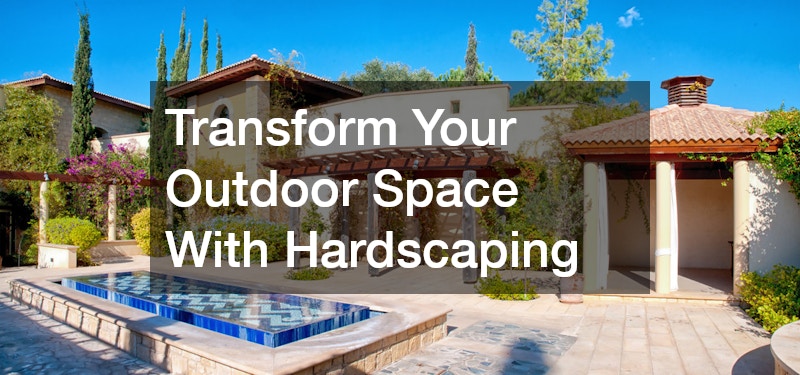
Hardscaping is an excellent way to elevate the aesthetic and functional dimensions of your outdoor space. This article delves into the essentials of hardscaping, guiding you through the various elements involved in transforming your yard into a beautiful and sustainable environment.
Hardscaping refers to the non-living elements of landscaping, including patios, walkways, retaining walls, and other structures made from materials like stone, concrete, and wood. While landscaping focuses on living elements such as plants and trees, hardscaping provides structural elements that create harmony and balance within the outdoor environment.
Video Source
Together, they form a cohesive and functional design that enhances the overall appeal of your property.
The key difference between hardscaping and landscaping lies in their roles: landscaping is about cultivating an organic, natural feel through greenery, whereas hardscaping introduces architectural features that support and enhance the living areas. Hardscaping often serves as the foundation for landscaping, providing areas for plants and lawns to thrive, and adding layers of texture and interest through varied materials.
By combining landscaping with hardscaping, you can design a comprehensive outdoor space that offers visual interest, functionality, and durability. Hardscaping not only supports the aesthetic beauty of a yard but also offers practical benefits, such as preventing erosion, managing stormwater, and creating usable outdoor living areas that extend the comfort of your home into the outdoors.
When considering materials for your hardscaping project, you have a variety of options to choose from, each offering unique benefits and suited for different purposes. Common materials include natural stone, such as granite or limestone, which offer timeless beauty and durability, making them perfect for patios and walkways. Concrete pavers, on the other hand, are versatile and come in various shapes and colors, providing a cost-effective solution for many hardscaping designs.
Another popular material is brick, known for its classic look and sustainable properties, as bricks can often be salvaged and reused in new projects. Additionally, wood can be used for decking and pergolas, offering a natural warmth and texture to the outdoor environment. It's important to consider not only the aesthetic appeal but also the maintenance requirements and longevity of each material to ensure it aligns with your specific needs and climate conditions.
Choosing the right materials involves assessing your budget, desired visual impact, and local climate. For instance, in areas prone to freeze-thaw cycles, selecting materials that can withstand temperature fluctuations is crucial to prevent damage and avoid costly repairs. Ultimately, the materials you choose should reflect your personal style, complement existing architecture, and withstand the test of time while requiring minimal upkeep.
Investing in hardscaping can significantly enhance the value of your property by boosting its curb appeal and functionality. Well-designed hardscaping features, such as elegant pathways, decorative retaining walls, and spacious patios, can create inviting outdoor spaces that prospective buyers find appealing. The right hardscaping can highlight the architectural features of your home and provide outdoor areas suitable for entertaining and relaxation.
By improving the layout and usability of your outdoor spaces, hardscaping can increase your home's marketability and attract potential buyers seeking a balance between indoor and outdoor living. Features such as outdoor kitchens, fire pits, and water features can create focal points that add luxury and enjoyment, making your home stand out in the real estate market. Providing a well-kept, aesthetically pleasing outdoor area can create a lasting first impression, often leading to a quicker sale at a higher price.
Additionally, hardscaping can improve the functionality of your outdoor space by addressing common issues such as poor drainage or sloped terrains. Well-designed retaining walls can prevent soil erosion, while permeable paving solutions can manage stormwater runoff, reducing environmental impact and demonstrating a commitment to sustainability. These improvements not only contribute to a pleasant and practical environment but also enhance the longevity and integrity of your property.
Hardscaping can indeed be environmentally friendly when sustainable practices and materials are employed. One of the ways it contributes to environmental conservation is through the use of permeable materials, which allow water to pass through and reduce runoff. This helps replenish groundwater sources and minimizes the impact on local waterways, thereby promoting a healthier ecosystem.
Incorporating native plants and drought-resistant vegetation around hardscaped areas can further enhance sustainability by reducing the need for irrigation. Choosing materials with lower environmental footprints, such as recycled concrete and sustainably sourced wood, can help minimize the ecological impact of construction. In addition, solar lighting options can be integrated into the hardscape design to reduce energy consumption while enhancing safety and ambiance.
Sustainable hardscaping also involves designing with the natural landscape in mind, working with the existing terrain rather than against it. By incorporating structures that conform to the land's natural slopes and curves, less disruption is caused to the ecosystem. Additionally, choosing the right materials and designs can lead to lower long-term maintenance, conserving resources and reducing the need for chemical treatments to protect surfaces.
Hardscaping offers a myriad of opportunities to transform your outdoor space into a stunning and functional area. Whether you're looking to enhance your home's value, embrace sustainable practices, or simply create a personal oasis, hardscaping can provide you with the tools to achieve your vision. Implementing the right strategies and materials can result in an enduring and beautiful landscape that you will enjoy for years to come.
